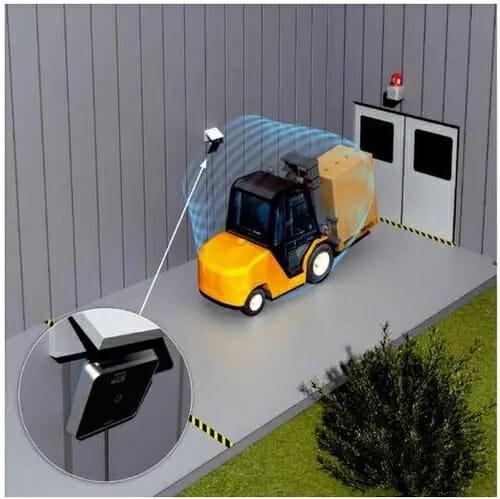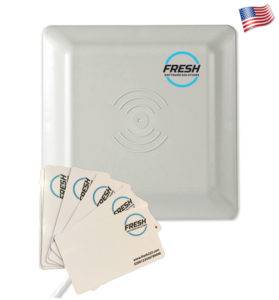Prices / Buy Systems Write A Request
Software Download Free Online Estimate
An RFID gate access control system is a technology-based security system that utilizes RFID (Radio Frequency Identification) technology to control and monitor access to a specific area or facility. It is commonly used in various environments such as office buildings, residential complexes, RFID parking lots, warehouses, and other restricted areas.
RFID Gate Access Control System: Revolutionizing Security and Efficiency
Introduction
Welcome to our comprehensive guide on RFID gate access control systems. At our Fresh USA company, we pride ourselves on delivering cutting-edge security solutions. In this article, we will delve into the world of RFID gate access control systems, discussing their benefits and how they can transform access management in various industries. Whether you’re a business owner, a facility manager, or simply interested in the latest advancements in security technology, this article will equip you with the knowledge you need to make informed decisions.
Free Online Estimate of Parking Access Control Systems


Understanding RFID Gate Access Control Systems
What is RFID?
Radio Frequency Identification (RFID) is a technology that utilizes radio waves to wirelessly transmit data between an RFID reader and a tag or label attached to an object. RFID tags typically consist of a microchip and an antenna, allowing them to communicate with RFID readers.
How Do RFID Gate Access Control Systems Work?

RFID gate access control systems leverage the power of RFID technology to streamline access control processes. By integrating RFID readers at entry points, such as gates or doors, organizations can enhance security and improve operational efficiency. The process begins when an individual approaches an RFID-enabled gate with their RFID tag.
As the individual’s RFID tag comes within range of the reader, the reader captures the unique identifier stored in the tag. This information is then transmitted to a centralized system for verification. If the tag’s information matches the authorized credentials in the system, the gate is automatically unlocked, granting access to the individual. This seamless and contactless authentication process not only enhances security but also minimizes queues and eliminates the need for physical keys or access cards.
Our RFID Gate Access Control Systems are fully compatible with the I-PASS system and function effortlessly in multiple states where E-ZPass is accepted. This means that users can continue using their existing RFID sticker tags from the I-PASS and E-ZPass network within our system, eliminating the need for additional tags or modifications. With integration across 19 states, our system ensures automatic vehicle identification at parking access points for a smooth and hassle-free experience.
Advantages of RFID Gate Access Control Systems
1. Enhanced Security
RFID gate access control systems provide robust security measures, mitigating the risks associated with traditional access control methods. By eliminating the reliance on easily replicated keys or swipe cards, these systems significantly reduce the chances of unauthorized access. Moreover, RFID tags can be programmed with specific permissions and access levels, ensuring that only authorized individuals can enter designated areas.
2. Increased Efficiency
With RFID gate access control systems, organizations can bid farewell to time-consuming manual processes and boost overall operational efficiency. The automated authentication process saves valuable time for both staff members and visitors, resulting in smoother access management. Additionally, the contactless nature of RFID technology minimizes physical contact, making it a hygienic and convenient option, especially in high-traffic environments.
3. Comprehensive Tracking and Reporting
RFID gate access control systems provide valuable insights into access patterns and visitor traffic. By capturing data each time a tag is read, organizations can analyze entry logs, identify peak periods, and gain a better understanding of facility usage. These reports can assist in optimizing security protocols, allocating resources effectively, and identifying any irregularities or security breaches.

Implementing RFID Gate Access Control Systems
1. Assess Your Requirements
Before implementing an RFID gate access control system, it’s crucial to evaluate your specific needs and objectives. Consider factors such as the size of your facility, the number of entry points, and the expected volume of users. Conducting a comprehensive assessment will help determine the appropriate type of RFID tags, readers, and software solutions required to meet your security and access control goals.
2. Designing the System
Collaborate with a trusted security solutions provider to design a tailored RFID gate access control system that aligns with your unique requirements. They will guide you in selecting the most suitable RFID readers, tag types, and placement strategies for optimal performance. A well-designed system should account for factors like signal range, environmental conditions, and integration with existing security infrastructure.
3. Installation and Integration
Once the system design is finalized, a team of experts will proceed with the installation process. RFID readers will be strategically positioned at entry points, ensuring optimal tag detection and communication. It is essential to integrate the RFID gate access control system with your existing access control software or security management platform. This integration enables seamless data synchronization and real-time monitoring of access events.
4. Staff Training and User Education
To ensure the successful adoption of the RFID gate access control system, comprehensive staff training and user education are paramount. Conduct training sessions to familiarize personnel with the new technology, its benefits, and the correct usage of RFID tags. Educate users on the system’s features, address any concerns, and emphasize the importance of following access control procedures diligently.
Conclusion
RFID gate access control systems offer numerous advantages, including enhanced security, increased efficiency, and detailed tracking capabilities. By seamlessly integrating RFID technology into your access control infrastructure, you can strengthen security measures while streamlining operations. Remember, a well-designed and properly implemented system, along with user training, is key to maximizing the potential of RFID gate access control systems.
Use of Long-Range Wireless Technologies In Vehicle Access Control Systems

RFID gate access control systems manufactured by FRESH USA have been tested for many years of use around the world and work perfectly in all weather conditions. Our systems use only contactless technologies such as Wi-Fi, 4G / LTE, and RFID UHF long range distance with a frequency of 860MHz – 960MHz. You can integrate the parking management software with other third-party software or your ERP system using a SQL database or deploy a Web-service.
Any RFID system, from Fresh USA is Your reliable choice.
The main advantage of a Gate Access Control System with RFID UHF technology is the high read range, which allows for efficient and convenient access control of vehicles without the need for physical contact or line-of-sight communication.
At our Fresh USA company, we specialize in providing top-notch security solutions, including RFID gate access control systems. Contact us today to explore how our expertise and innovative technology can help you revolutionize your access control processes. Your security is our priority.

Chicago RFID Gate Access Control Systems
RFID Access Control Systems: Your Ultimate Guide
In today’s tech-savvy world, safeguarding properties, businesses, and even residential areas has become easier thanks to advancements in technology. One of the most reliable, convenient, and efficient ways to manage and control access is through RFID access control systems. This article will delve deep into the functionality, advantages, and practical applications of RFID access control systems. Whether you’re looking to enhance security for your home or business, this guide will provide everything you need to know.
Free Online Estimate of Access Control Systems
What is RFID?
Understanding RFID Technology
RFID stands for Radio Frequency Identification. It’s a technology that utilizes electromagnetic fields to automatically identify and track tags attached to objects. These tags store data that can be read by an RFID reader without physical contact, making them perfect for access control systems. When incorporated into security systems, RFID technology ensures seamless and secure access to specific areas, replacing the need for traditional keys or codes.
How Do RFID Access Control Systems Work?
RFID access control systems function using three essential components:
- RFID Tags or Cards: These tags hold unique identifiers that are programmed into the system. They are often carried by individuals or attached to items for identification.
- RFID Readers: The RFID reader emits a radio signal that powers up the RFID tag and retrieves the data stored within it.
- Control Panel/System: The control panel processes the data received from the RFID reader, determines the validity of the access request, and allows or denies entry.
Key Advantages of RFID Access Control Systems
- Contactless Operation: Users don’t need to physically touch the reader; they only need to pass the tag near it for authentication.
- High Security: RFID access control systems store encrypted data, making it difficult for unauthorized individuals to clone or forge RFID tags.
- Convenience: Forget carrying physical keys. An RFID card or tag can easily be attached to a keychain, and some systems even allow smartphone integration.
Free Online Estimate of Access Control Systems
Types of RFID Access Control Systems
There are various types of RFID access control systems available, each catering to different security needs and settings. Let’s explore the most popular types:
Passive RFID Systems
Passive RFID systems are the most common type used in access control systems. They do not have an internal power source but rely on the RFID reader to send out a signal that powers the tag. These systems are generally used for short-range access control, such as opening doors or gates in residential and commercial properties.
Active RFID Systems
Active RFID systems, unlike passive ones, have their own internal power source, allowing them to work over longer distances. These systems are often used in large facilities, warehouses, and parking lots where long-range access control is required.
Hybrid RFID Systems
Hybrid systems combine the best of both passive and active RFID technologies, providing versatile security solutions. These are particularly useful in multi-tiered security settings, such as gated communities or business parks.
Free Online Estimate of Access Control Systems
Benefits of RFID Access Control Systems
Enhanced Security
RFID access control systems offer a significant upgrade from traditional locks and keys. Each RFID tag is unique and encrypted, making duplication extremely difficult. Moreover, these systems can track who enters and exits, providing real-time data on access logs.
Convenience and Efficiency
Gone are the days of lost keys or forgotten codes. With RFID access control systems, you simply need your RFID card or tag. The system also allows for quick and seamless access, reducing wait times and bottlenecks at entry points.
Versatility in Use
RFID access control systems are versatile and can be used in various settings, including:
- Residential properties: Homeowners use RFID systems to secure their homes and manage access for family members or guests.
- Commercial spaces: Businesses use RFID technology to manage employee access and track movement within their premises.
- Parking garages: Automated access for vehicles entering or exiting parking lots becomes efficient with RFID systems.
Key Components of RFID Access Control Systems
RFID Tags
RFID tags come in different forms, such as cards, fobs, or stickers. Each tag stores data that is used to identify the person or object carrying it. In an access control system, this data is linked to specific permissions within the control panel.
RFID Readers
The RFID reader is responsible for retrieving the data stored in the tag. These readers are often installed near entry points, like doors or gates. Depending on the system, RFID readers can function at various ranges, from a few centimeters to several meters.
Access Control Panel
The access control panel is the brain of the entire system. It stores and processes all the data, making decisions about who can and cannot gain access to a property or specific area. Modern panels often come equipped with cloud-based software, allowing real-time monitoring and remote management.
Free Online Estimate of Access Control Systems
Installing RFID Access Control Systems
Installation Process
Installing RFID access control systems typically requires professional assistance, especially for complex setups. However, some DIY options are available for simpler systems, such as those used in small residential properties. Here are the basic steps involved:
- Site Assessment: Identify critical access points and security needs.
- Installation of Readers: Install RFID readers at designated access points.
- Software Setup: Program the control panel and configure user permissions.
- Tag Distribution: Distribute RFID tags or cards to authorized users.
Maintenance and Upgrades
Like any technology, RFID access control systems require regular maintenance to ensure continued functionality. Tags may need to be replaced, and software may require updates. In addition, upgrading your system periodically can help keep your security measures up-to-date with the latest innovations.
Factors to Consider When Choosing RFID Access Control Systems
Security Needs
Assessing your security needs is the first step in choosing the right RFID access control system. For higher security, active RFID or hybrid systems might be more suitable. Conversely, smaller properties or businesses may find passive RFID systems more than sufficient.
Budget Considerations
The cost of installing RFID access control systems can vary widely depending on the system’s complexity and the number of entry points. Be sure to factor in the initial investment, as well as ongoing maintenance costs.
Scalability and Future Proofing
Consider a system that can grow with your needs. RFID access control systems are easily scalable, meaning you can add more entry points or advanced features without needing a full overhaul of the system.
Free Online Estimate of Access Control Systems
Conclusion
RFID access control systems have revolutionized the way we secure our homes, businesses, and various other properties. Their contactless operation, enhanced security features, and ease of use make them a superior alternative to traditional locks and keys. Whether you’re looking to safeguard a residential property or manage access in a commercial setting, RFID technology is a forward-thinking solution that provides reliability and peace of mind.
From controlling access to tracking entry logs, RFID systems deliver a robust solution to modern security challenges. With proper installation, maintenance, and upgrades, these systems ensure that you can enjoy both convenience and enhanced protection for years to come.
FAQs
What is the difference between passive and active RFID systems?
Passive RFID systems do not have their own power source and rely on the reader to power them, whereas active RFID systems have an internal battery allowing them to transmit signals over long distances.
How much does it cost to install an RFID access control system?
The cost varies depending on the complexity of the system and the number of access points, but basic systems can start around $500, while more advanced setups may cost several thousand dollars.
Can RFID systems be hacked?
While no system is completely foolproof, RFID access control systems employ encryption and other security measures to make hacking extremely difficult.
Are RFID access control systems suitable for residential properties?
Yes, RFID systems are perfect for residential properties. They offer enhanced security and convenience for homeowners.
Can I integrate an RFID system with my existing security system?
Yes, most modern RFID access control systems can be integrated with other security features such as cameras, alarms, and intercoms.




